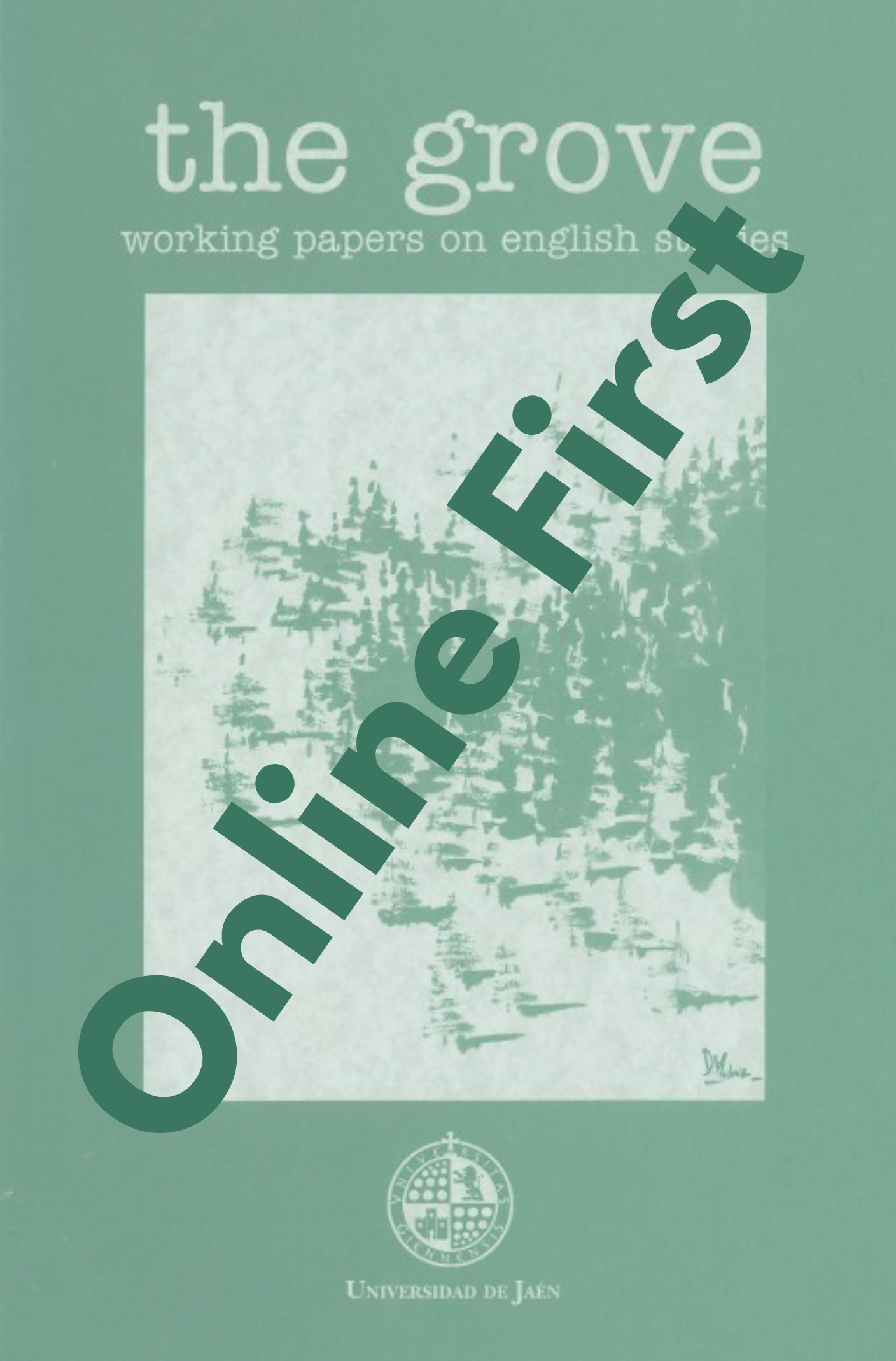Interior Landscapes: An Ecocritical Reading of Kazuo Ishiguro's The Buried Giant
DOI:
https://doi.org/10.17561/grove.v32.8815Keywords:
Kazuo Ishiguro, The Buried Giant, landscape, ecocriticism, intertextuality, vegetationAbstract
Given the ecocritical potential of many of Ishiguro’s novels, more ecocritical analyses should be carried out on his works. This paper aims to read The Buried Giant (2015) through an ecocritical lens and show how the setting of the novel exemplifies and adds new aspects to ecocritical concepts, such as the disappearance of the landscape, the undermining of anthropocentrism and the silence of nature. The first section will focus on the concept of the ‘embodied landscape’ and will be concerned with ways in which landscape undercuts notions of man’s superiority through the memories of past events it is able to retain, unlike the characters, who are utterly deprived of their memory. The second section will examine the symbolism of trees and greenery so as to show how they seem to be linked to memories and contribute to filtering them, thus letting some memories re-emerge from the collective forgetfulness.
Downloads
References
Ahearn, Victoria. “Kazuo Ishiguro Looks at Role of Memory in History with ‘The Buried Giant.’” The Canadian Press, 19 Mar. 2015, https://toronto.citynews.ca/2015/03/19/kazuo-ishiguro-looks-at-role-of-memory-in-history-with-the-buried-giant/. Accessed 24 Mar. 2024.
Allen, Graham. Intertextuality, 3rd ed., Routledge, 2022.
Allen, Nicholas. “Seamus Heaney and Water.” The Irish Review (Cork) no. 49/50, 2014/2015, pp. 173–82, https://www.jstor.org/stable/44473891. Accessed 24 Mar. 2024.
Brent, Jonathan. “Violence, Memory, and History: Geoffrey of Monmouth and Kazuo Ishiguro’s The Buried Giant.” Cambridge Journal of Postcolonial Literary Inquiry vol. 8, no. 3, 11 Oct. 2021, pp. 323–44, https://doi.org/10.1017/pli.2021.17. Accessed 24 Mar. 2024.
Buell, Lawrence. “Ecocriticism: Some Emerging Trends.” Qui Parle, vol. 19, no. 2, 2011, pp. 87–115, https://doi.org/10.5250/quiparle.19.2.0087. Accessed 24 Mar. 2024.
Carruth, Allison. “On Bog Lands and Digital Markets: Seamus Heaney’s Recent Poetry.” Pacific Coast Philology, vol. 46, no. 2, 2011, pp. 232–44, https://www.jstor.org/stable/41851027. Accessed 24 Mar. 2024.
Clark, Alex. “Kazuo Ishiguro’s Turn to Fantasy.” The Guardian, 19 Feb. 2015, https://www.theguardian.com/books/2015/feb/19/kazuo-ishiguro-the-buried-giant-novel-interview. Accessed 24 Mar. 2024.
Clark, Timothy. The Value of Ecocriticism, Cambridge University Press, 2019.
Conrad, Joseph. Heart of Darkness, 2nd ed., Penguin Classics, 2007.
Filipova, Lenka. Ecocriticism and the Sense of Place, Kindle ed., Routledge, 2022.
Frost, Robert. “Mending Wall.” Poetry Foundation, https://www.poetryfoundation.org/poems/44266/mending-wall. Accessed 24 Mar. 2024.
Groes, Sebastian, and Dominic Dean. “Reading Kazuo Ishiguro in Times of Crisis.” English Studies, vol. 103, no. 7, 15 Feb. 2023, pp. 1017–27, https://doi.org/10.1080/0013838X.2022.2159124. Accessed 24 Mar. 2024.
Heaney, Seamus. “Bogland.” Poeticous, https://www.poeticous.com/seamus-heaney/bogland. Accessed 24 Mar. 2024.
---. “Digging.” Poetry Foundation, https://www.poetryfoundation.org/poems/47555/digging. Accessed 24 Mar. 2024.
Homer. The Odyssey. Translated by Robert Fagles, Penguin Books, 2006.
Hufstader, Jonathan. “‘Coming to Consciousness by Jumping in Graves’: Heaney’s Bog Poems and the Politics of North.” Irish University Review, vol. 26, no. 1, 1996, pp. 61–74, https://www.jstor.org/stable/25484649. Accessed 24 Mar. 2024.
Iovino, Serenella. Ecologia letteraria, 3rd ed., Edizioni Ambiente, 2020.
Iovino, Serenella. Paesaggio civile, il Saggiatore, 2022.
Ishiguro, Kazuo. Interview with Allan Vorda and Kim Herzinger. “An Interview with Kazuo Ishiguro.” Mississippi Review vol. 20, no. 1/2, 1991, pp. 131–54, https://www.jstor.org/stable/20134516. Accessed 24 Mar. 2024.
---.. The Buried Giant, 2nd ed., Faber and Faber, 2021.
---. The Remains of the Day, Faber and Faber, 1999.
---. Interview with Graham Swift. “Kazuo Ishiguro.” BOMB no. 29, 1989, pp. 22–23, https://www.jstor.org/stable/40423890. Accessed 24 Mar. 2024.
“Kazuo Ishiguro: By the Book.” The New York Times, 5 Mar. 2015. https://www.nytimes.com/2015/03/08/books/review/kazuo-ishiguro-by-the-book.html. Accessed 24 Mar. 2024.
Landow, George P. Hypertext 3.0: Critical Theory and New Media in an Era of Globalization, 3rd ed., The Johns Hopkins University Press, 2006.
Magee, Audrey. The Colony, Kindle ed., Faber and Faber, 2022.
Mason, Gregory, and Kazuo Ishiguro. “An Interview with Kazuo Ishiguro.” Contemporary Literature vol. 30, no. 3, 1989, pp. 335–47, https://doi.org/10.2307/1208408. Accessed 24 Mar. 2024.
Mason, Jessica. Intertextuality in Practice, John Benjamins Publishing Company, 2019.
Parker, Ingrid M. “Remembering in Our Amnesia. Seeing in Our Blindness.” Arts of Living on a Damaged Planet. Eds. Anna Tsing, Heather Swanson, Elaine Gan and Nils Bubandt. University of Minnesota Press, 2017, pp. M155–67.
Pratt, William. “The Great Irish Elk: Seamus Heaney’s Personal Helicon.” World Literature Today, vol. 70, no. 2, 1996, pp. 261–66, https://doi.org/10.2307/40152041. Accessed 24 Mar. 2024.
Reece, Shelley C. “Seamus Heaney’s Search for the True North.” Pacific Coast Philology, vol. 27, no. 1/2, 1992, pp. 93–101, https://doi.org/10.2307/1316716. Accessed 24 Mar. 2024.
Russell, Richard Rankin. “Ishiguro’s The Buried Giant: The (Re)turn to Fantasy from The Remains of the Day.” The Comparatist, vol. 45, 2021, pp. 300–323, https://www.jstor.org/stable/10.2307/27085527. Accessed 24 Mar. 2024.
Shaffer, Brian W., and Kazuo Ishiguro. “An Interview with Kazuo Ishiguro.” Contemporary Literature vol. 42, no. 1, 2001, pp. 1–14, https://doi.org/10.2307/1209082. Accessed 24 Mar. 2024.
Stacy, Ivan. “Looking Out into the Fog: Narrative, Historical Responsibility, and the Problem of Freedom in Kazuo Ishiguro’s The Buried Giant.” Textual Practice, vol. 35, no. 1, 9 Aug. 2019, pp. 109–128, https://doi.org/10.1080/0950236X.2019.1652677. Accessed 24 Mar. 2024.
Stern, Lesley. “A Garden or a Grave? The Canyonic Landscape of the Tijuana-San Diego Region.” Arts of Living on a Damaged Planet. Eds. Anna Tsing, Heather Swanson, Elaine Gan and Nils Bubandt. University of Minnesota Press, 2017, pp. G17–29.
Teo, Yugin. “Monuments, Unreal Spaces and National Forgetting: Kazuo Ishiguro’s The Buried Giant and the Abyss of Memory.” Textual Practice, 18 May 2022, pp. 1–22, https://doi.org/10.1080/0950236X.2022.2056757. Accessed 24 Mar. 2024.
Valančiūnas, Deimantas. “Forgetting or Making to Forget: Memory, Trauma and Identity in Kazuo Ishiguro’s The Buried Giant.” History, Memory and Nostalgia in Literature and Culture. Ed. Regina Rudaitytė. Cambridge Scholars Publishing, 2018, pp. 213–28.
Vernon, Matthew, and Margaret A. Miller. “Navigating Wonder: The Medieval Geographies of Kazuo Ishiguro’s The Buried Giant.” Arthuriana vol. 28, no. 4, 2018, pp. 68–89, https://www.jstor.org/stable/45015571. Accessed 24 Mar. 2024.
Vogel, Steven. “The Silence of Nature.” Environmental Values, vol. 15, no. 2, 2006, pp. 145–71, https://www.jstor.org/stable/30302146. Accessed 24 Mar. 2024.
Walkowitz, Rebecca L. “Unimaginable Largeness: Kazuo Ishiguro, Translation, and the New World Literature.” NOVEL: A Forum on Fiction, vol. 40, no. 3, 2007, pp. 216–39, https://www.jstor.org/stable/40267701. Accessed 24 Mar. 2024.
Weik von Mossner, Alexa. “Feeling Nature: Narrative Environments and Character Empathy.” Environment and Narrative: New Directions in Econarratology. Eds. Erin James and Eric Morel. The Ohio State University Press, 2020, pp. 129–46.
Wong, Cynthia F. Kazuo Ishiguro, 3rd ed., Liverpool University Press, 2019.
Wood, Gaby. “Kazuo Ishiguro: ‘Most Countries Have Got Big Things They’ve Buried.’” The Telegraph, 27 Feb. 2015. https://www.telegraph.co.uk/culture/books/11436950/Kazuo-Ishiguro-Most-countries-have-got-big-things-theyve-buried.html/. Accessed 24 Mar. 2024.
Yiping, Wang. “Ethnic War and the Collective Memory in Kazuo Ishiguro’s The Buried Giant.” English Studies, vol. 102, no. 2, 15 Mar. 2021, pp. 227–42, https://doi.org/10.1080/0013838X.2021.1886671. Accessed 24 Mar. 2024.
Published
Issue
Section
License
Copyright (c) 2025 Costanza Mondo

This work is licensed under a Creative Commons Attribution 4.0 International License.
Authors who publish with this journal agree to retain copyright and grant the journal right of first publication with the work simultaneously licensed under a Creative Commons Attribution License that allows others to share the work with an acknowledgement of the work's authorship and initial publication in this journal. Also, authors will retain the rights on their work, even if they will be granting The Grove. Working Papers on English Studies a non-exclusive right of use to reproduce, edit, distribute, publicly communicate and show their work. Therefore, authors are free to engage in additional, independent contracts for non-exclusive distribution of the works published in this journal (such as uploading them to an institutional repository or publishing them in a book), as long as the fact that the manuscripts were first published in this journal is acknowledged.
























